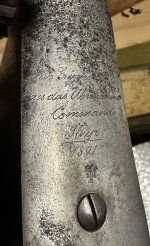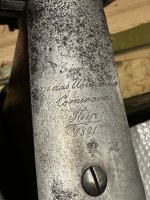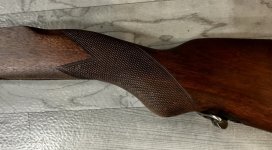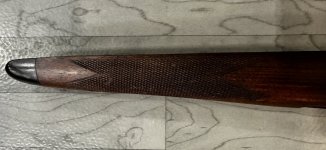The date doesn’t make much sense, nor does the spelling of Commando with a “c” versus “k” if in German.
There are a lot of French loan words in German for military matters, and a fair bit of the time you find the spelling with the French "c" rather than the German "k" earlier on, and it changes over time along with other spelling tweaks. French "compagnie" becomes Kompagnie, Companie and Kompanie. By the time you get to WW2 most of these loan words are more fully Germanized, but if you're talking about the 19th century things can get pretty wild. Even more so pre-unification, as there were a lot of regional spellings that got flattened out by increased centralization and standardization around Berlin, and a lot of the states that had their center of gravity more around the Rhineland (e.g. Wurttemburg) can have a lot more of the Francophone spellings.
Interestingly this also holds true in non-military areas but those seem to get Germanized a lot faster. You'll find instances of Compagnie and Kompagnie a lot in business matters, for example, but anecdotally at least it feels like that never gets fully Germanized but just switched over to Gesellschaft and other strictly German words. Again, it feels like companies closer to French influence tend to be more comfortable with the French versions. The initial version of Mauser when it was a privately held small firm was Gebrüder Wilhelm & Paul Mauser, but when they got backing from the Württembergische Vereinsbank and formed a limited partnership company they became Gebrüder Mauser & Compagnie, which you'll see shortened as Gebr. Mauser & Co on Gew 71 rollmarks, and occasionally Gebr. Mauser & Cie in writing. The latter is interesting because it's using the French form for abbreviating Compagnie, while the rollmark is using the German. Then in the 1880s when they reform as a joint stock company they become Waffenfabrik Mauser, Kommanditgesellschaft auf Akten and ditch the French all together.
Interestingly, while you do see less of the French influence further east, it is there. Ludwig Loewe & Co. was formed in 1869 in Berlin, and it's full name at the time was Ludwig Loewe & Co., Commanditgesellschaft auf Actien Für die Fabrikation von Nähmaschinen. I don't fully understand the exact reasons because my economic history is weak, but the Prussian state at that time didn't have its act together as far as corporate law went in the way that the French did, hence using a lot of French economic and legal terms. That very quickly became Ludwig Loewe & Co, Kommanditgesellschaft auf Akten the same as we see with Mauser up above. I'll also note that I've never seen the Cie. abbreviation for LL&Co, just the Co.
Anyways it's all a bit of a mess and I don't have a good explanation for the where and why of how these lines got drawn as far as using the loan word vs. a Germanicized loan word vs. a natively German word, but there are certainly some rough patterns.
Which to bring it all back around to your rifle, I suspect there's something similar going on there with "Kommando/Commando." My French is weak, and looking up a solid answer is stymied by the fact that "Commando" in French now has basically the same special forces meaning that it does in English, but if I had to guess it was probably a partial Germanizatoin of Commandement, which I'm pretty sure would be the equivilent word in French, but they handn't dropped the C yet.
edit: Oh, and of course keep in mind that Steyr is, of course, in Austria and I'm not even beginning to take into account the weird stuff that can go on when you're talking pre-WW1 Austrian German. I have next to no experience with documents from that era, but if I was going to take a wild guess from the hip I'd probably lean towards them having more of a French influence as well.











